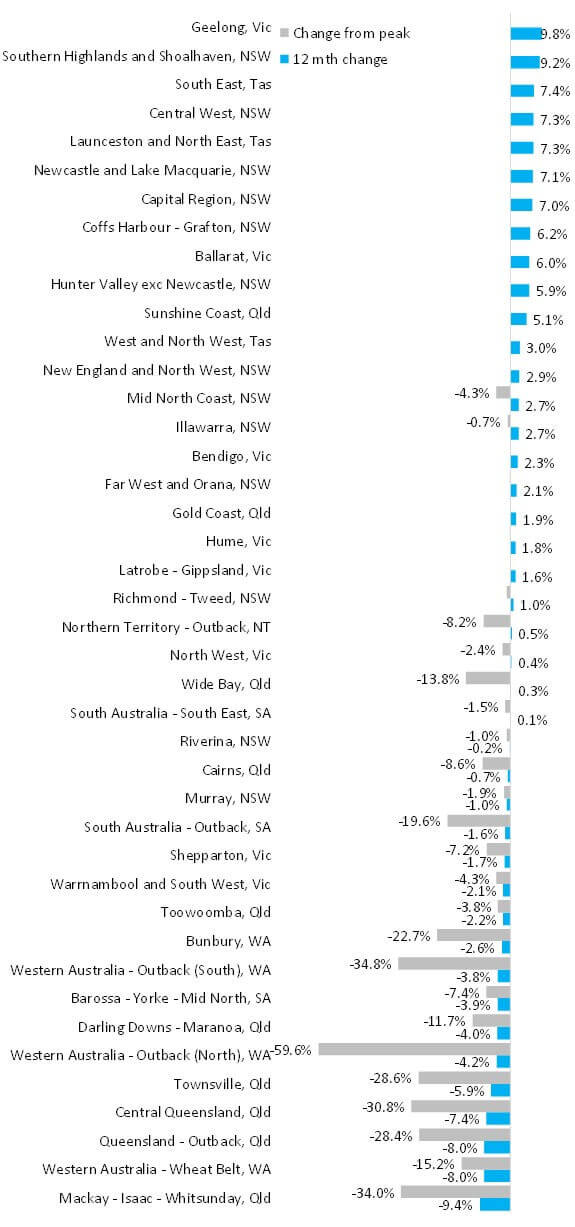In this week’s Property Pulse we check-in on the regional areas of the country and look at how values have increased over the past year and where they sit relative to previous peaks.
Over the 12 months to April 2018, dwelling values across the combined regional markets have increased by 2.4% compared to a -0.3% fall in values across the combined capital cities. Although values in regional areas are continuing to rise, the rate of annual growth has slowed from a recent peak of 6.4% in June 2017, although the rolling quarterly rate of growth has shown an accelerating trend over the past six months.
Based on the ‘Statistical Area level 4’ (SA4) geography, there are 42 regions across Australia outside of the capital cities. Of these 42 regions, 25 have recorded an increase in dwelling values over the past year while the remaining 17 have recorded falls. Each SA4 region in Western Australia recorded a fall in values over the past year while all of the regional areas of Tasmania and the Northern Territory saw values increase over the past year.
Change in values across regional SA4 markets as at April 2018

Geelong recorded the greatest increase in values across regional Australia over the past year with values rising by 9.8%. At the other end of the scale, the Mackay-Isaac-Whitsunday region of Queensland recorded the greatest value falls, down -9.4%. Generally speaking, values in regional Australia are growing quickest in those regions relatively close to major capital cities while weakness persists in those regions linked to the mining and resources sector. While dwelling values are lower in most mining related areas over the past twelve months, many areas have seen a noticeable improvement in the rate of decline relative to previous years.
While regional dwelling values are continuing to climb, albeit at a slower pace, values across a number of these markets remain below their historic peaks. Of the 42 regions, only 16 regions have dwelling values that are currently at historic high levels. The Outback (North) region of Western Australia has dwelling values that are currently furthest away from the previous peak level, down -59.6% from October 2012 when values hit a record high.
Focusing on those regions in which values remain below their peak, regions linked to the mining and resources sector typically have current dwelling values which are furthest away from their peak. Seven SA4 regions across the country currently have values which are down at least 20% from their peak and all of them, except Bunbury in Western Australia, are directly linked to the mining and resources sector. Each of these seven regions have continued to record a decline in dwelling values over the past year. Although many of these regions are showing signs they are beginning to recover, it will likely be a long way back to their previous historic peaks.
Although regional markets are continuing broadly to see dwelling values increase, the rate of growth has slowed in a number of major regions. In fact, 12 months ago Illawarra was the best performing regional market for value growth with values 17.4% higher over the year compared to growth of just 2.7% over the past 12 months. While no regional market recorded annual growth in excess of 10% over the past year, four regions had a year ago (Illawarra, Southern Highlands and Shoalhaven, Richmond-Tweed and Geelong). Only 13 of the 42 regional markets have recorded stronger value growth over the past 12 months compared to the previous 12 months.
While value growth is anticipated to remain stronger in regional markets than in capital cities over the coming year, it is expected that those regions close to Sydney in particular, will continue to experience a slowdown in their rate of value growth as interstate migration outflows trend higher and jobs growth becomes more broadly spread outside of New South Wales and Victoria. Regional markets nearby to Melbourne, Hobart and Brisbane are the most likely to experience an uptick in value growth thanks to strong migration flows and more affordable housing costs. Additionally, lifestyle markets are well positioned to see growing demand from cashed up baby boomers who have seen a substantial wealth injection from housing value growth in Sydney and Melbourne.


